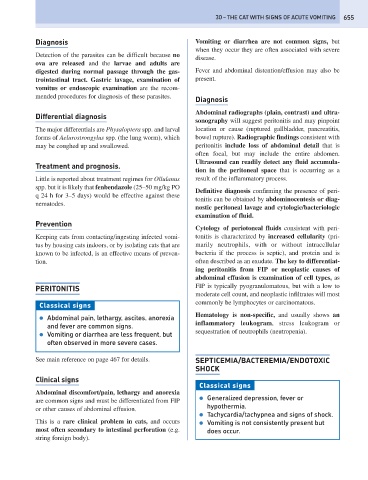Page 663 - Problem-Based Feline Medicine
P. 663
30 – THE CAT WITH SIGNS OF ACUTE VOMITING 655
Diagnosis Vomiting or diarrhea are not common signs, but
when they occur they are often associated with severe
Detection of the parasites can be difficult because no
disease.
ova are released and the larvae and adults are
digested during normal passage through the gas- Fever and abdominal distention/effusion may also be
trointestinal tract. Gastric lavage, examination of present.
vomitus or endoscopic examination are the recom-
mended procedures for diagnosis of these parasites.
Diagnosis
Abdominal radiographs (plain, contrast) and ultra-
Differential diagnosis
sonography will suggest peritonitis and may pinpoint
The major differentials are Physaloptera spp. and larval location or cause (ruptured gallbladder, pancreatitis,
forms of Aelurostrongylus spp. (the lung worm), which bowel rupture). Radiographic findings consistent with
may be coughed up and swallowed. peritonitis include loss of abdominal detail that is
often focal, but may include the entire abdomen.
Ultrasound can readily detect any fluid accumula-
Treatment and prognosis.
tion in the peritoneal space that is occurring as a
Little is reported about treatment regimes for Ollulanus result of the inflammatory process.
spp. but it is likely that fenbendazole (25–50 mg/kg PO
Definitive diagnosis confirming the presence of peri-
q 24 h for 3–5 days) would be effective against these
tonitis can be obtained by abdominocentesis or diag-
nematodes.
nostic peritoneal lavage and cytologic/bacteriologic
examination of fluid.
Prevention
Cytology of periotoneal fluids consistent with peri-
Keeping cats from contacting/ingesting infected vomi- tonitis is characterized by increased cellularity (pri-
tus by housing cats indoors, or by isolating cats that are marily neutrophils, with or without intracellular
known to be infected, is an effective means of preven- bacteria if the process is septic), and protein and is
tion. often described as an exudate. The key to differentiat-
ing peritonitis from FIP or neoplastic causes of
abdominal effusion is examination of cell types, as
PERITONITIS FIP is typically pyogranulomatous, but with a low to
moderate cell count, and neoplastic infiltrates will most
commonly be lymphocytes or carcinomatous.
Classical signs
Hematology is non-specific, and usually shows an
● Abdominal pain, lethargy, ascites, anorexia
inflammatory leukogram, stress leukogram or
and fever are common signs.
sequestration of neutrophils (neutropenia).
● Vomiting or diarrhea are less frequent, but
often observed in more severe cases.
See main reference on page 467 for details. SEPTICEMIA/BACTEREMIA/ENDOTOXIC
SHOCK
Clinical signs
Classical signs
Abdominal discomfort/pain, lethargy and anorexia
● Generalized depression, fever or
are common signs and must be differentiated from FIP
hypothermia.
or other causes of abdominal effusion.
● Tachycardia/tachypnea and signs of shock.
This is a rare clinical problem in cats, and occurs ● Vomiting is not consistently present but
most often secondary to intestinal perforation (e.g. does occur.
string foreign body).

